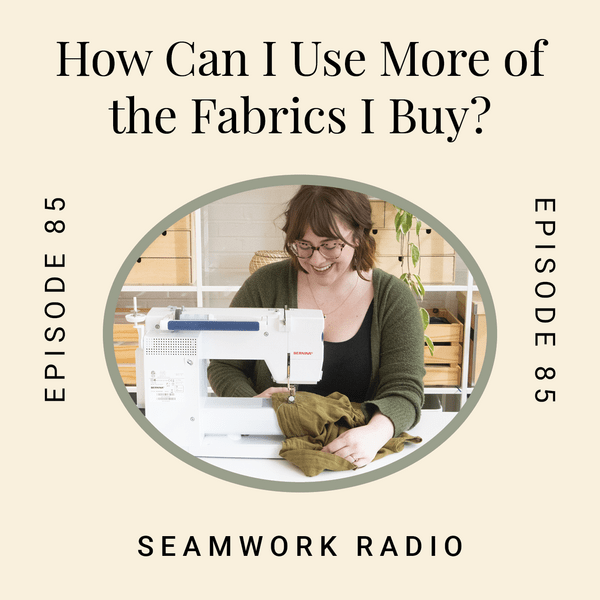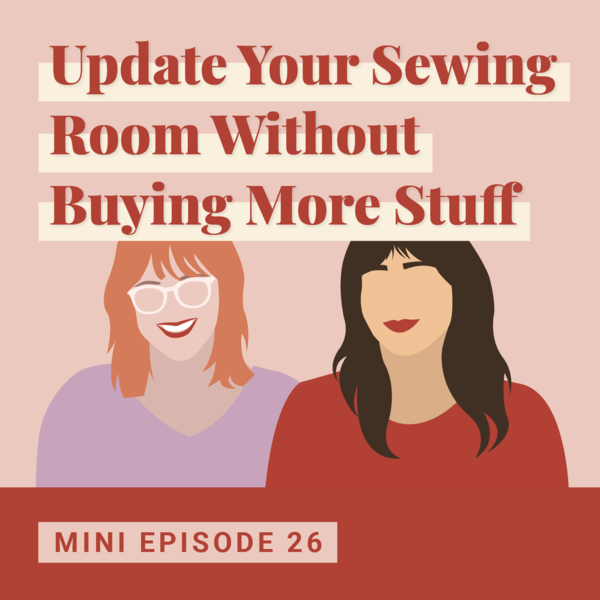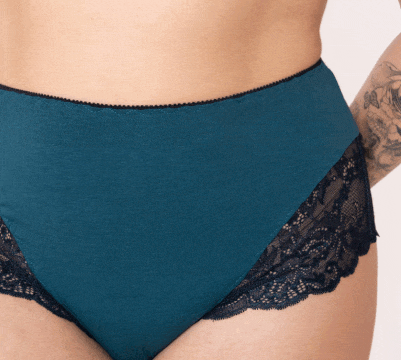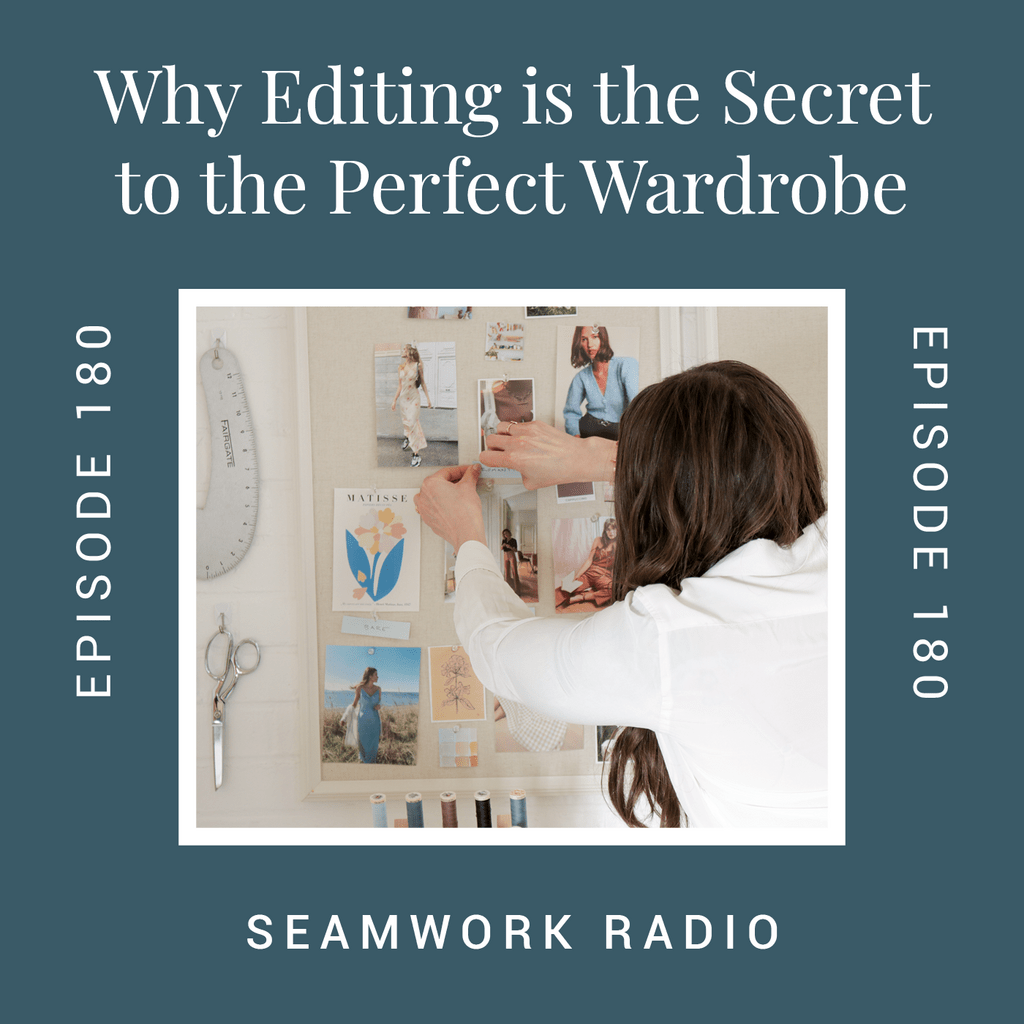Here's something you might not know about yourself: You're an editor.
When you sew your own clothes, you're always making editorial decisions, from pairing fabric to a pattern to styling a final outfit.
Improving your editing skills empowers you to make thoughtful choices in your sewing projects—so you sew things you love to wear.
Without effective editing, you may create items you appreciate aesthetically but don't fit your personal style.
In this episode, Sarai and Haley cover why editing is so important in design, how to set constraints to make editing easier, and ideas for making tough choices a little bit easier.
Below are the show notes for this podcast episode and a brief summary of what's covered, followed by a full transcript.
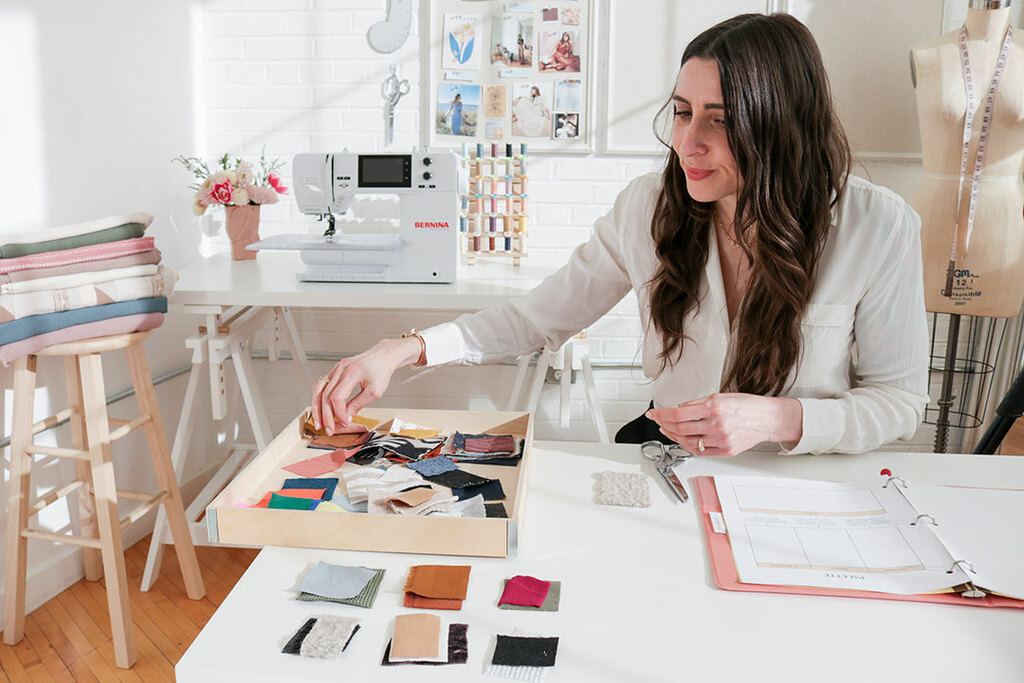
Show Notes
-
The Extended Mind, The Power of Thinking Outside the Brain: by Annie Murphy Paul. -
Making Time: Sarai’s personal newsletter. -
Style Workshop: 10 creative exercises to help you define your core style. -
Podcast listeners get half off an unlimited Seamwork membership when you use this link, plus you get to keep that price as long as you’re a member! - Tell us your idea for the next icebreakers for makers!
Tips to Improve Your Editing Skills
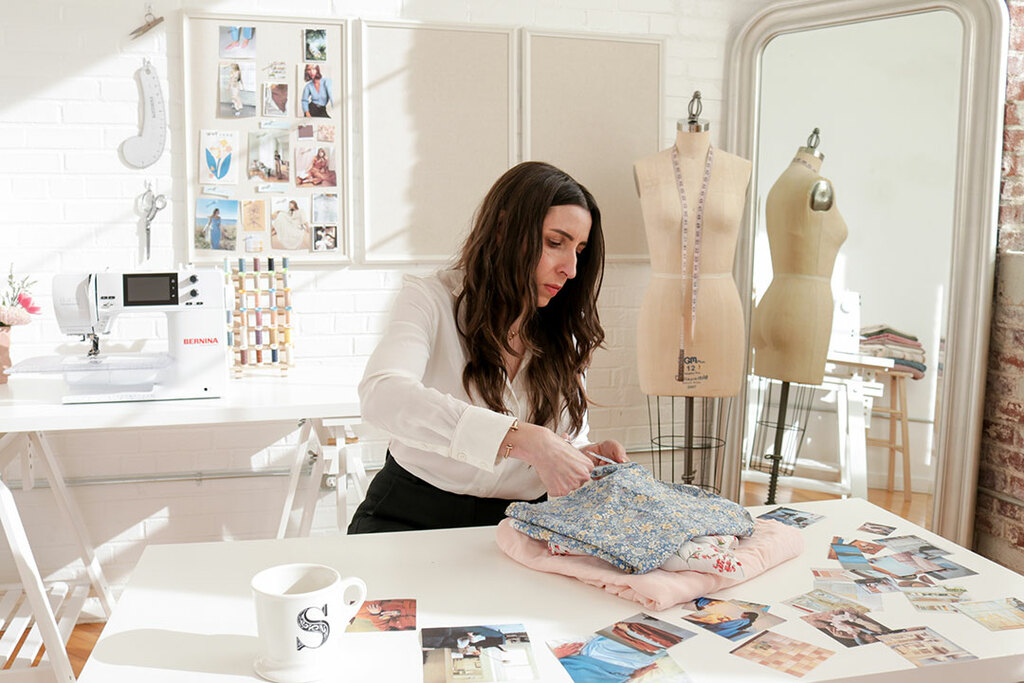
Set design constraints
The trick to editing is setting up constraints in advance.
Design constraints are any practical considerations that limit your range of options, forcing you to combine elements in new ways to develop creative solutions.
Some constraints you can set include the weather where you live, what you do throughout the day, and the fabrics you like to wear.
If a piece of clothing doesn’t fit the constraints you set up, move on and sew something else.
Look for outside systems to help you set constraints
Some people like to use systems, like color seasons or body types to help set constraints. If you’re having trouble editing, these are good tools to set constraints. Instead of creating your own rules, you can borrow ones someone else has researched.
Don’t be afraid to repeat
Repetition is very useful for your wardrobe. If there’s a garment you wear all the time, make it the center of your outfits. Focus your inspiration and fabric choices on what you most frequently wear, and wear it repeatedly.
For example, if you wear a blazer four times a week, look for inspiration, outfits, and fabrics that work with blazers. If you never wear a blazer, half of your mood board shouldn’t be blazers.
Go with your gut
If you hesitate about a silhouette, color, or fabric, you won’t wear it. You know what it feels like to wear something that doesn't feel like you.
It’s helpful to learn to recognize the difference between the excitement you feel when you see a piece of clothing you love and the excitement you feel when you see a piece of clothing you would love to wear all the time.
Do multiple passes
You aren't meant to edit in one fell swoop. Rather than eliminating a bunch of options, do multiple passes. Your first cuts might be mostly gut feelings. Then you can do another pass and cut out any repeats.
Add a few more rounds of cuts, and you can start getting more analytical and bringing in your design constraints.
Editing is perpetual in your wardrobe
Think about the lifecycle of a piece of clothing—editing is there at each phase. When you sew your own clothes, you have to edit your inspiration, mood board, fabrics, and outfits.
And finally, you edit again when you purge your closet.
So, don’t be afraid of editing. You’ve been doing it all along, but now you can do it with more intention.
Podcast Transcript
Sarai
I'm Sarai.
Haley
And I'm Haley.
Sarai
And this is Seamwork Radio. Welcome back to Seamwork Radio, where we share practical ideas for building a creative process so you can sew with intention and joy.
Today, we're talking about the editing process for your wardrobe, and we're going to cover why editing is so important in design, how to set constraints to make editing easier, and ideas for making tough choices a little bit easier.
All right, Haley, our icebreaker for today. What music is on your sewing playlist this month?
Haley
This is a fun one. And full disclosure, Sarai and I had to look at our Spotify.
Sarai
Yeah, we've just been staring at our phones for like, ten minutes.
Haley
To figure out what exactly we've been listening to as we're filming this. It's early January, and so lots of December for me was Christmas music. But another playlist that I had in heavy rotation was a 1970s playlist, and it had a lot of like Lou Reed and Patty Smith and David Bowie on it.
Sarai
All great choices.
Haley
Very. I mean, I stand beside every single one of them. What about you, Sarai? What are you listening to?
Sarai
I was looking at mine and I've been listening to a lot of Nina Simone lately, and always, I just love Nina.
Haley
Can't be mad at that.
Sarai
Amazing. Baltimore is one of my favorite albums, and Kenn gave it to me on vinyl for Christmas, maybe the year before last, and I have it here in my sewing shed, but my record player is broken, so have been listening to it on Spotify lately and it's such a beautiful album. If you haven't listened to either Nina Simone or that album in particular, Baltimore, it's wonderful. And all of her albums are beautiful.
All right, well, that was a fun way to start this episode today. If you have an icebreaker for us, leave it for us at seamwork.com/go/icebreakers and we'll likely use it on a future episode. That link will take you to a post on our community where you can share your idea for icebreakers.
All right, today we are talking about editing. So editing is a really key process in Design Your Wardrobe, which is our process for helping you to design a seasonal wardrobe. And when you think about designing, you often think about iterating and creating designs. But the real power can come when you edit out ideas.
So editing is really the process of taking a wide range of ideas and narrowing them down into a more defined concept and honing your editing skills is really what's going to help you to create the wardrobe you really want and to make impactful choices when it comes to sewing, because otherwise, you often end up with things that you like but you don't necessarily like to wear. So there's a difference there.
So, tell me a little bit about your editing process. Haley, what do you like about the editing process?
Haley
I have to say, I'm, like, a little bit of an editing nerd. I love editing. I get such enjoyment from even just, like, editing text. I love making ideas concise and really digestible, because I think that ideas are more, to me, maybe this is just my brain, but I find ideas oftentimes to be more impactful, the more concise they are.
Our brains cannot absorb and remember huge pieces of information, and I think that's the same for inspiration, that it can be really hard to focus ourselves unless our inspiration is the correct bite size for our personal preferences.
So I think, in general, those are the things that I like about the editing process, like, the specific thing I like. I love making cuts. Just brutal cuts. I'm really into it. My husband is always, like, he'll ask for my design input often when he's working on an architectural project, and he also admires my ruthlessness.
Sarai
That's a really good quality to have, especially when it comes to design, being able to do that. I think you make a really good point about the similarities between editing in this context and editing in, for example, written word or something like that, because I do feel like design is sort of a process of storytelling, and if you can simplify a story down to what's really important about it, then your point comes across so much more clearly. So I think that's a really apt metaphor. I don't know if it's a metaphor. It's an apt comparison.
Haley
What do you find that you like the most about the editing process?
Sarai
I think the freedom that comes from less is very inspiring to me. I find it difficult to make those cuts and to take things down to the basics. But I think there's a lot of freedom once you do it, and being able to see that clear picture once you've made those difficult decisions, I think is really inspiring to me.
So, again, it kind of comes back to storytelling and being able to gain more clarity.
Haley
Yeah. Is there a place that you find that you struggle the most with editing?
Sarai
I struggle with it everywhere, really. I like to collect things and gather things, and I'm always looking for more and more and more ideas. So being able to cut some of those ideas feels very painful to me. And it's hard for me to distinguish between 100 different ideas that I love and really choose the best ones. But that's why it's so important to me, because it is such a struggle. That means that it's probably even more necessary for me to do just because it's very easy for me to get overwhelmed, whether that's with the number of projects I have going on, sewing projects, home projects, whatever it is or the things I commit to in my life or whatever, that's definitely always a struggle for me, which is why editing is so important.
What about you?
Haley
I feel like, for me, making cuts is the easy part. I feel like it's the front part of the work, which we're going to get into in a little bit here, which is setting the constraints that help you to make those editing decisions easier, because I feel like once you have a set of constraints, the choices usually come second nature.
So I think for me, the hard part is just setting those constraints and it depends on the context in which I'm setting them. If it's for a brand or for Seamwork, I have data that can help me to back my decision. Those are constraints that are easier to set.
Setting the constraints for myself can be a little bit more challenging. Personal constraints. We have some good tips to get into on all of that in just a few moments here.
Before we do, though, I have one more question, and that is, how has your editing process evolved over time?
Sarai
I think it's become a lot more structured. I think in the past, when it comes to sewing, at least I would make whatever I felt like making, which is fun, and that's one way to go about it. And I'm sure many of you do the same thing. But over time, I've become a lot more structured in designing what I sew, and that has really helped me to make better choices about what I spend my time on.
And it's also allowed me to make things that actually work with my life and work with who I am as a person.
It just makes me a lot happier with what I actually create in the end.
So having a structured design process has been really life changing for me and has taught me a lot about other areas of my life and how to pour more design into different areas of my life, which has also been really helpful. What about you?
Haley
Yeah, I agree. I think that when I first started sewing and creating things, it was very intuitive, and as a result of that, my editing was. I don't even know if it really existed. It just was a stream of consciousness.
And then as I started developing my editing skills, it started from a place of intuition, and then it moved into learning to utilize constraints as a tool. Data. When you're designing for a brand, you do need to lean into what people actually want and buy.
But I think that it all came together when I learned to combine all of those things, because constraints are lovely and helpful in the editing process. But you do need to also be in touch with what feels right.
Sarai
Yeah. I think another thing that might be a factor, especially in our personal projects, is I do feel like when you're younger, you lean more towards experimentation and trying new things and just kind of figuring yourself out. And as you get older, not only do you have a better sense of what your own style is and what's important to you, but I think you just gain that skill of being able to say no to things that don't fit who you are anymore.
Haley
Yeah.
Sarai
And I think that's much harder to do when you're younger and you haven't quite figured that out yet. And I think that's a totally normal and natural and healthy thing to go through at all stages. I don't think there's a right or wrong or better, but it's just something that, for a lot of people, I think changes.
Haley
Yeah, definitely. I think there's these times where you're more in touch with your constraints, naturally, and then there's other times where you need to figure them out a little bit more, and that's totally okay.
Or times when you don't need constraints at all. You just need to have fun and explore a little bit.
Well, we keep on talking about all these constraints, but we ought to dig into them a little bit deeper. So we're to jump into our tips for editing.
And number one. Surprise, surprise. Set design constraints. So, design constraints are really any practical consideration that limit your range of options. This is really great because that forces you to combine elements in new ways or to create some creative solutions to problems.
So what are some things that can be design constraints? They could be as simple as the weather. What is the weather like, the time of year that you're designing for? What do you do day to day? Are you a lawyer? Are you in the courtroom? You may not need to make a whole bunch of new loungewear, but if you work from home, I don't know, maybe you do.
It can also be the fabrics you prefer to wear or fabrics that are appropriate, again, for the climate that you're in. So design constraints don't have to be complicated. They can just simply be the facts of your life.
Sarai
Yeah, I think this is a really huge one. For me, at least. I think this is something that's really changed the way I sew and wear clothing. I feel like when I was younger, I used to just like what I liked, and I would wear things or buy things that were totally not, I wouldn't say inappropriate, but they were not like the garment you would think would be appropriate for a certain situation.
I just would wear what I want. And I feel like nowadays I take a lot of these considerations when I'm deciding what I'm going to spend my money or my time on. And even if I really love to wear something, it might not be practical for me to wear it very often. And that definitely factors into what I want to actually make.
Haley
Yeah, definitely. I feel that. I mean, I remember the days where I used to be totally willing to go stand out in line, to go see a show in a mini skirt in the freezing cold. And you know what? Not so much anymore.
If it's going to be cold, I’m going to be warm.
Sarai
Yeah. I remember in the days when I had a job working, a very physically demanding job working in a warehouse, and I would still wear dresses just because I liked wearing dresses. It was totally impractical for what I was doing, but I was 22 or whatever, and that's what I wanted to wear.
Not saying that's a bad thing. It's just something that's changed again over time. And now I'm just a lot more choosy than I used to be.
Haley
I mean, and the constraint for some people may be that they don't really like that those kinds of factors don't impact their choices as much.
Sarai
Right.
Haley
And for you, you might have hard limitations on those things.
Sarai
Yeah. It's all about getting in touch with what matters to you and what's important to you.
All right, the next tip is to look for outside systems to help you with setting constraints. So what we mean by that, by outside systems, is if you have some difficulty figuring out what kinds of constraints would make sense for your life, you might like to use something like color, seasons, or Kibbe body types or something that can help you to kind of put boundaries around what you want to invite into your life, what you want to sew, what you want to wear.
So I think those can be really helpful. They're not helpful for everyone, but if you are having trouble editing, they can be really good tools to help you set those constraints. Do you use anything like that, or have you ever?
Haley
I'm curious about those things. I don't personally use them as constraints in my wardrobe, but I definitely have colors that I just don't feel as good in, and I don't like wearing close to my face or silhouettes that I just feel like don't bring out the best in me. It's not necessarily about what's most flattering or not, or what makes me look the smallest in my body. It's just the things that I don't feel like are like personal reflections of how I want to be perceived.
Sarai
Yeah, I think that's a really good point. If you take the body types thing for an example, even if you don't believe that that is actually something that exists or something that is objectively helpful, I think even just having boundaries that make sense to you can really help you to just make some kind of choice.
If you have trouble making choices. I think it can still eliminate some of that mental taxation, even if objectively, it doesn't make a big difference if you're this type or that type.
Haley
Yeah, totally makes sense.
Sarai
Yeah, I think they're really interesting to learn about. I've never really dug too deep into them, but I think they're kind of interesting.
Haley
Yeah, I know I've said it on previous podcasts, but I'm like, if anyone out there listening is an expert on one of these things, we would love to talk to you.
Sarai
Yeah, definitely.
Haley
I'm very fascinated.
Okay, so let's jump into tip number three, which is repetition is useful for your wardrobe, and don't be scared of it.
So when you're looking at your inspiration and your outfits and fabric choices, it's important to think about what you most frequently wear and also what you're most willing to repeat time and time again in your wardrobe. And it's also important when you're seeking inspiration and throughout the design process, whether that's looking for the inspiration, shopping for fabric, creating your looks. You want to make sure that what you're creating is proportional to your real life and your real life constraints.
So, for instance, if you wear a blazer four times a week, then looking for a lot of different inspiration and outfits and fabrics that are appropriate for a blazer makes a lot of sense for you. But if you never wear a blazer, maybe you could edit all of those pictures of blazers out of your inspiration, unless that's something that you're really looking to incorporate in. So focusing on repetition, but also making sure that it's proportional to your unique constraints.
Sarai
Yeah, I think that's a really important point, and that looking at what you've done in the past can provide a lot of information for what's going to work for you in the future. So I think that's a really helpful way of thinking about it that will actually, I think, be extremely practical for a lot of people, too.
Haley
Yeah. And I think you have to also get kind of acquainted with how comfortable you are with repetition. Some people like to wear basically an iteration of the same thing every single day.
I think it was my friend Christine who called dressing like this like a Flintstone dressing, where it's like the same thing over and over again, maybe in a different color, although I think that the Flintstones just wore the exact same thing. But some people love doing that and some people don't. So the variety in your wardrobe or the variety that you want to have in your wardrobe should be reflected throughout your design process.
Sarai
Yeah, definitely. I feel like this is something that's changed for me as well, where I used to be really into having a lot of variety, and now I'm a lot more comfortable wearing elements that are the same multiple times a week. And it feels good to do that.
Tip number four is to go with your gut. So if you have hesitation about a certain silhouette or a color or a fabric, there's a high probability you're not actually going to wear it. So I don't think this is always true. There are sometimes when you might want to experiment with something that you're not quite sure about, and maybe it will work out.
But I think just listening to what your gut says and how you feel emotionally about certain things can really help you to make those decisions, especially if the decision is something that you're kind of waffling on and you're not quite sure about, or if you're choosing between two things and it's been really hard for you, then going with your gut can really help you to, I think, learn things that might not be apparent to you consciously. I'm reading this book right now called The Extended Mind that's about thinking outside of your brain.
So thinking, using your body, using your social networks, using the environment, and I think there's a concept called. I think it's called interrospection. So being able to understand the feelings that are going on in your body and interpret them, and I think that's a really interesting way of thinking about it, in that your thoughts don't just occur in your mind, they're occurring also in your body.
And the more you can tune into those, the more you can really make better decisions. So I think that's a really interesting way of looking at it.
Haley
Yeah, I'm a big fan of when in doubt, go with your gut.
Okay, our next tip is to make sure that you're doing multiple passes. Don't do all of your editing all at once. So this is kind of related to going with your gut. But I always like to do my first pass as just, like, gut feelings of what needs to be trimmed and also trimming out anything that I feel like is really repetitive in my inspiration and my fabric selections and my iterations, things like that.
And then my next few passes are cuts where I am getting really analytical about constraints. So you can go kind of one constraint at a time. You can look at like, okay, this next round, I'm going to look at weather or climate constraints, and you can eliminate all of the things that don't work for the climate. Your next round after that can be lifestyle constraints, and you can eliminate those things by taking this more like, systematic approach. It can be a lot easier to make significant edits because you're not editing it down by 50% in one pass. You're just eliminating a couple of things every single pass.
Sarai
Yeah, that makes it a lot easier.
And then finally, the last tip is the editing is perpetual in your wardrobe, and it's really there at every phase. So you're editing starting with your inspiration. When you're collecting inspiration, you need to edit that. And then if you create a mood board, there's an editing process there. And then in choosing fabrics that you're going to sew with and creating outfits. And then finally, when you purge your closet and decide what you want to keep and what you want to get rid of, you're also editing there.
So editing is this ongoing process that happens throughout the lifecycle of a piece of clothing, especially a piece of clothing that you're making. You're able to make even more editing decisions when you're sewing something than just when you're buying something. So just remember that that is something that you're going to be doing continually. It's not something you need to do once a single decision, but something that you can do over and over.
And because of that, if you can hone the skill and really get good at editing, it's going to benefit you all across the board as you create as you sew and as you build your wardrobe.
So it's an extremely useful skill to have, and it transfers to other parts of your life, too.
Haley
Yeah, I found that when I learned to be more concise or more decisive in my professional decisions that it really had a trickle effect. And I imagine it probably would have the same effect if you started one place. And then it'll reach its little fingers out to other places.
Sarai
Yeah, absolutely.
All right, well, just to recap for you guys today, the tips we shared for editing are, first, to set design constraints.
Two, to look for outside systems that can help you to set those constraints.
Three, to remember that repetition is useful for your wardrobe.
Four, to go with your gut when you're not sure.
Five, do multiple passes to make decision making a lot easier.
And six, that editing is perpetual in your wardrobe, and it's there at every single phase.
All right, what's your big takeaway from this episode, Haley?
Haley
Oh, gosh. I don't know if I have one specific takeaway. I just feel really nerdy about how excited I am to talk about editing. I just am really passionate about this, and I feel like it really is the secret sauce. So that's really my only takeaway. Sorry. It's nothing mind altering.
Sarai
Well, for me, editing is something I've been thinking a lot about as we start this year. So we're recording this in early January, and I'm embarking on a project this year to really try and slow my life down. I'm writing about it on my personal newsletter called Making Time. If you guys want to subscribe to that, we'll put a link to that in the show notes, I guess. But I'm trying to really slow down by culling things out of my life, starting with clothing, but including a lot of other things, too.
And that's a difficult process for me, but it has a lot of really positive effects, and I find that when I can make those really tough decisions and pare down what I invite into my life, then my life is a lot happier, and I'm able to appreciate what I have a lot more.
So it's something I've been really, really thinking about a lot. And a lot of these tips I think, apply outside of the realm of just design or outside of the realm of sewing your own wardrobe. I think they are all applicable to multiple aspects of your life.
So if you struggle with doing less or having less, I think you can approach it in this very creative way and see it as part of a creative process rather than a sacrifice that you need to make. And for me, that's been a really helpful mindset shift.
All right, well, speaking of editing, one thing that really helps me with editing, with setting constraints is having a really great grasp on what my own personal style is. And if that's something that's interesting to you, you might be interested in our Style Workshop. So the Style Workshop is a hands on workshop that walks you through exercises to help you identify your core style. And it's also a really great process to go through before you tackle any other kind of wardrobe planning.
And it's free for Seamwork members, but if you aren't a member, it's only $10.
And we'll put those links in the show notes as well. And if you liked this episode today, please consider leaving us a five star review. We would love to hear from you. So you can leave that on your podcast platform of choice. Whether that's Apple Podcasts or Spotify or wherever you're listening to us right now, we really, really appreciate and we read every single review. It means the world to us when we hear from you guys with a positive review.
That's it for us today. I'm Sarai.
Haley
And I'm Haley.
Sarai
And this is Seamwork Radio.
